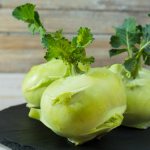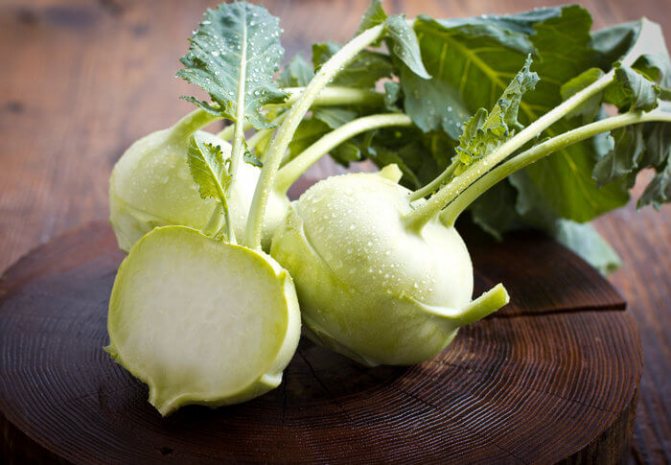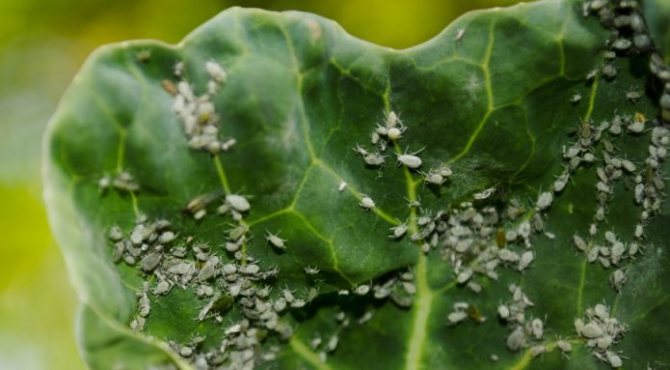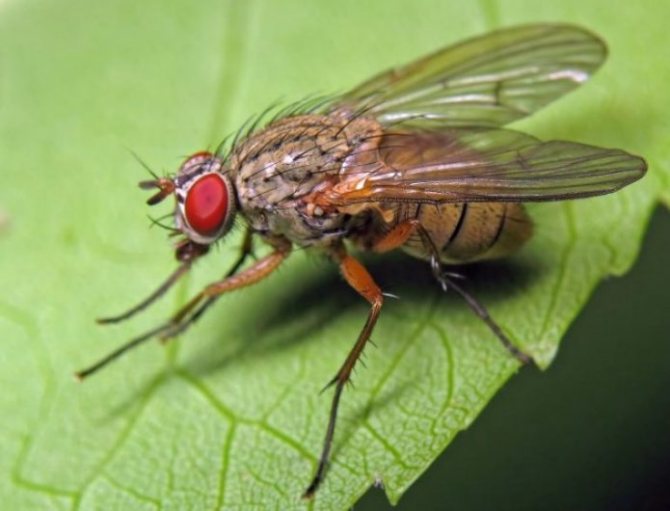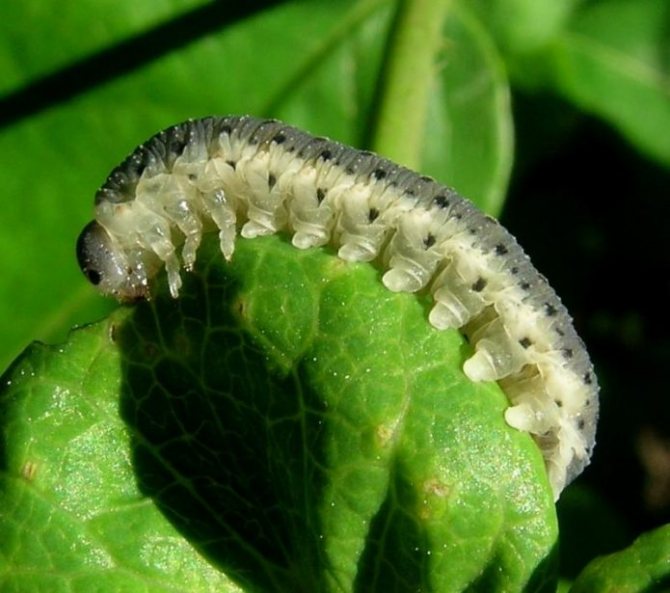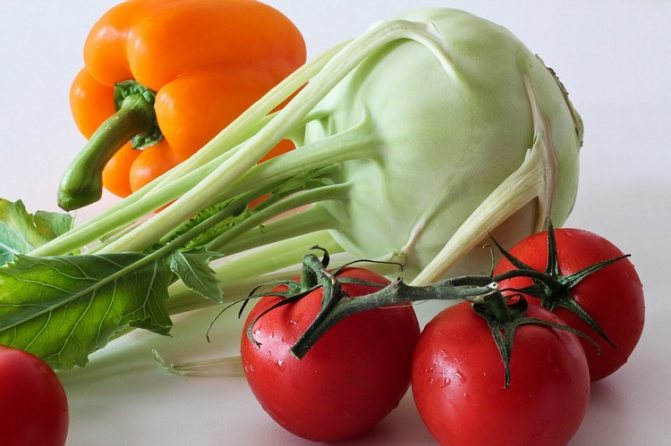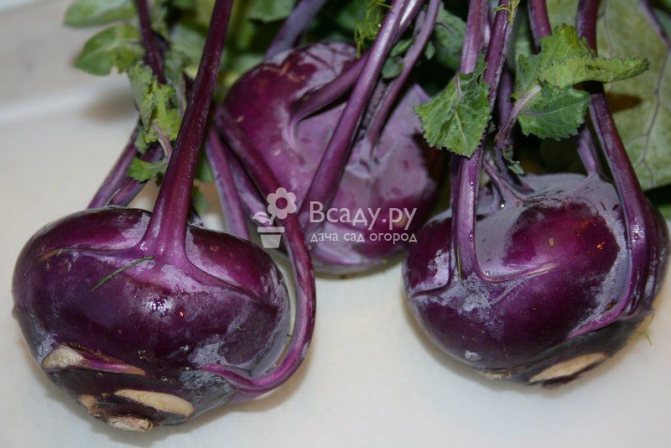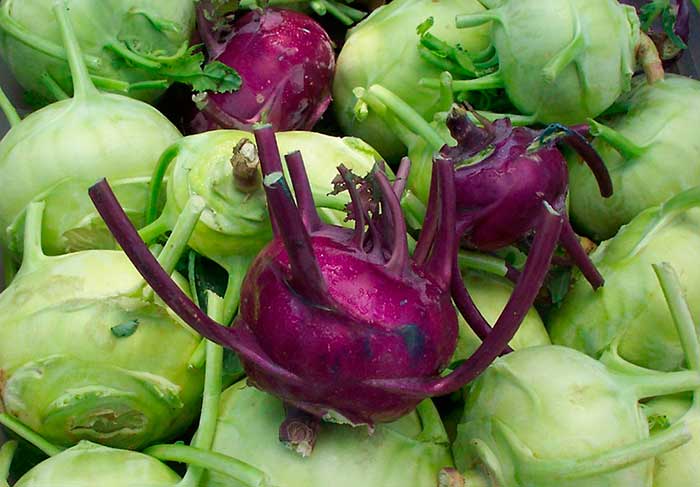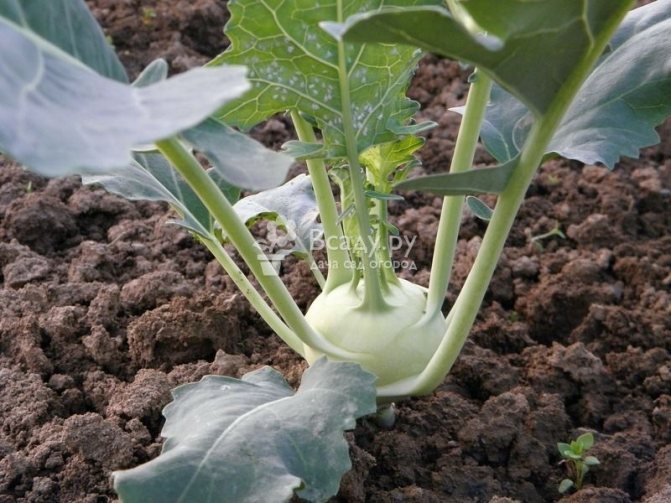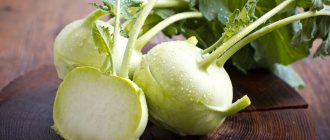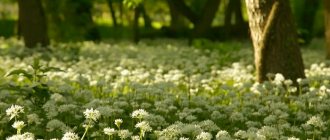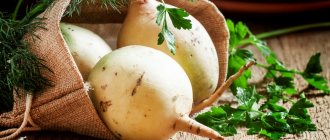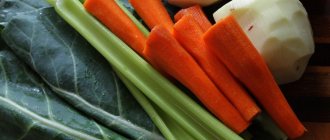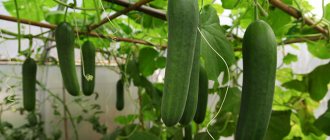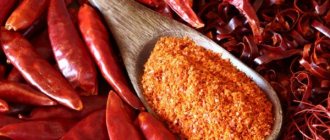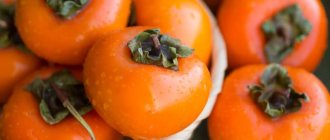Increasingly, you can see a vegetable that looks like a turnip or a radish in stores. Many do not pay attention to him and pass by, and very much in vain. After all, this is kohlrabi - an incredibly healthy cabbage. For its unusual appearance, it got its name, which in German means "Cabbage turnip"... It differs from other varieties of cabbage not only in appearance, but also in taste. The value for human health lies in the stem of the cabbage and its leaves.
Unusual and strange-looking kohlrabi cabbage
What is kohlrabi
Mediterranean cabbage with the unusual name "kohlrabi" is not a usual head of cabbage, but a stem plant. To the taste of kohlrabi distantly resembles tender and juicy radish pulp... It belongs to two-year-old plants. After planting, after a couple of months (depending on the variety), a short stem (stem crop) is formed. In the second year, a shoot up to 1 meter long grows from the upper bud, on which a brush appears, then flowers and a fruit in the form of a pod with seeds.
Stems in shape can be round, ovoid, orbicularly flat. The colors are also different: dark red, purple, pale green. The vegetable weighs differently, most often from 200 to 800 grams... Its leaves are green with a slight waxy bloom.
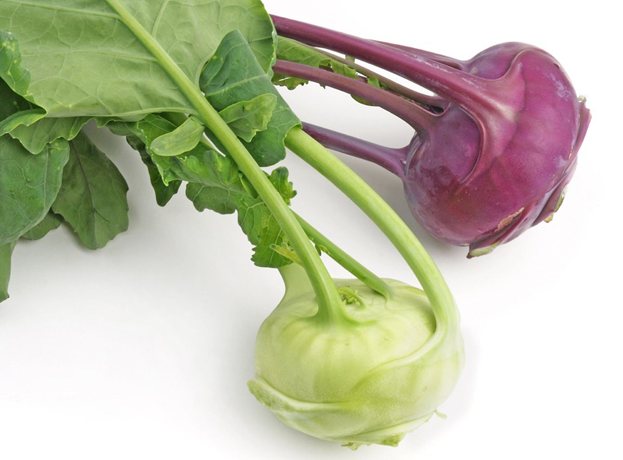
Different varieties of kohlrabi
Kohlrabi is an early ripening and unpretentious plant, so it fell in love with the inhabitants of the northern regions and it was there that it became widespread. For a record amount of ascorbic acid and a persistent attitude to frost, the cabbage root received the nickname "northern lemon".
Diseases and pests and how to deal with them
Young kohlrabi cabbage is most susceptible to attack by the following pests:
- Cruciferous flea. Symptoms: insects disturb the surface layer of the seedlings. During growth, the leaves break and die. Struggle: pollinate seedlings and seedlings with dust at intervals of 7 days. Fertilizers, in the form of nitrate, increase the seedling's immunity.


Cruciferous flea pest of kohlrabi cabbage
- Cabbage fly. Symptoms: The larvae attack the root system. The lower leaf turns blue, and the bush withers. Struggle: sprinkle sand mixed with naphthalene or thiophos solution on the soil around the plant.
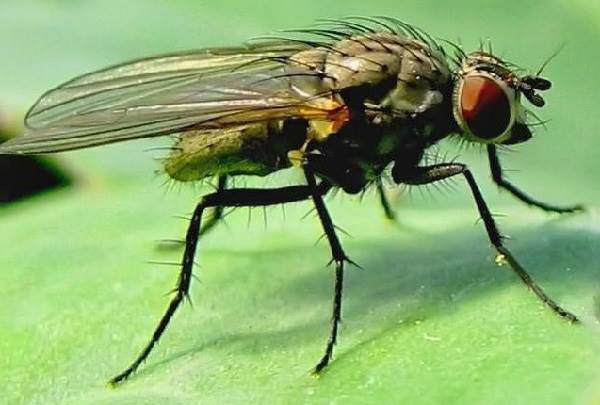

Cabbage fly pest
- Cabbage moth. A crop affected by pests is not ready for winter storage and is used for a short time. Symptoms - the leaves are piercing through. Fight: treat the bushes with insecticides.


Cabbage moth
Diseases
- White rot. Favorable prerequisites for infection are a cold snap with high humidity. Mucus appears on the outside of the stem. Cracked specimens are especially susceptible to disease. When the first symptoms are found, damaged fruits are isolated from the general harvest. Contact with healthy specimens will result in a new infection.
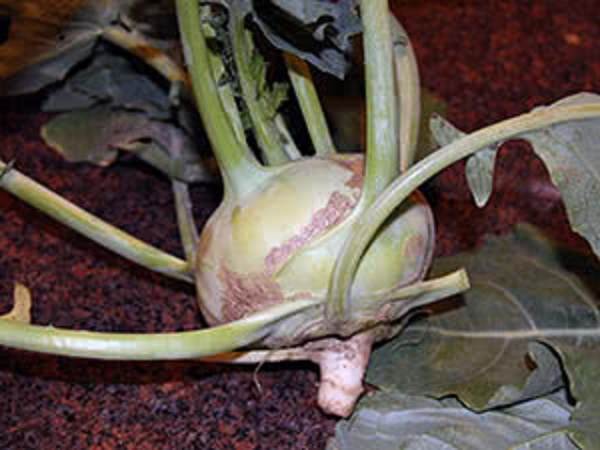

Correct agricultural techniques will help to get rid of the disease, which says that crop rotation should be observed, not to return to the field earlier than 3 years later. During storage, comply with the following conditions: temperature - 0 degrees C, the room is disinfected.
- Keela. The root system is affected, where growths appear. Struggle: remove diseased bushes and burn. Add colloidal sulfur to the soil.It will not be possible to save kohlrabi cabbage from viral diseases, only to uproot the culture and burn it.
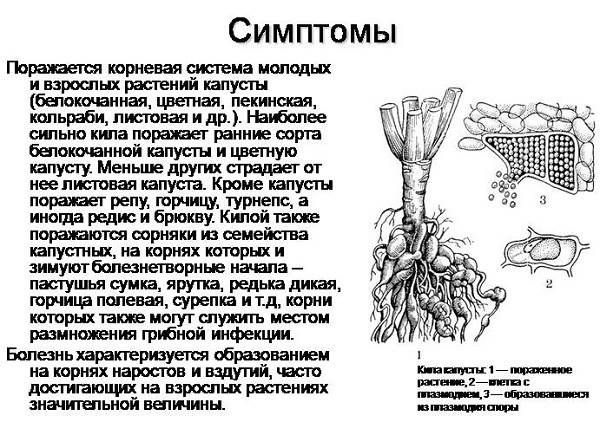

Origin and description
The family that is native to kohlrabi is cruciferous, as well as for white cabbage. All varieties have a whitish-pistachio-colored insides, but purple kohlrabi tastes more pungent, while green cabbage is more tender, with a sweetish flavor. In addition, the raspberry-purple stems contain slightly more potassium and folate.
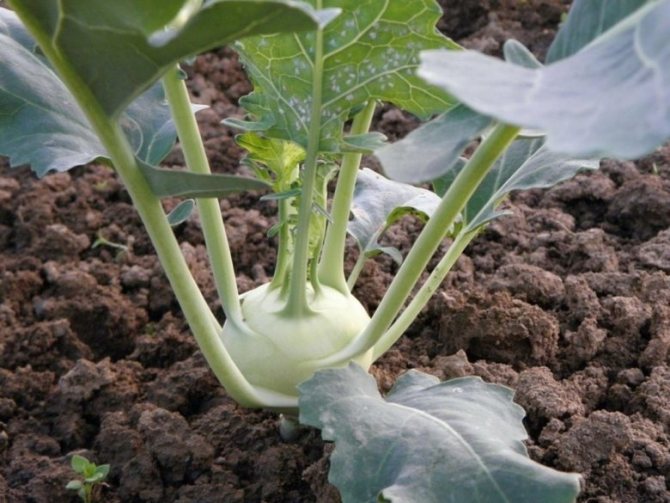

This is how kohlrabi grows in the garden, one of the most ancient types of cabbage.
More than 2000 years ago... In ancient Rome, kohlrabi was eaten only by the poorest strata of the population - slaves and gladiators. There it was called the stem turnip, and it sounded like "kaulorapa". In the 16th century, it came to Europe, namely to Germany, where the peasants began to actively cultivate it. From them, kohlrabi spread throughout Europe.
Today it takes pride of place on the tables of Italians, Dutch, Germans, Poles, Belarusians. In Russia, kohlrabi is not as popular as white cabbage, but many gardeners grow it and have already appreciated all the benefits of this unusual vegetable.
Types and varieties of kohlrabi
Among the large number of varieties and types of kohlrabi, early and late are distinguished. Let's consider those of them that are the most popular and in demand in the market.
Vienna white
This variety belongs to the early maturing varieties. The stem fruit grows in 65-70 days. Its color is light green, its shape is round. The maximum size is 7 cm. The pulp has a pleasant juicy, delicate white structure. Vienna White is planted in greenhouses and open ground. It is poorly stored, so you need to eat it as soon as possible.
Violet
Late variety of cabbage. It is characterized by excellent taste. The outside is deep purple, but the inside is white. Favorable growing conditions, good soil lead to the fact that the stem grower can grow up to 2 kg. Withstands low temperatures, drought, does not deteriorate during long-term storage.
Madonna
Belongs to the late varieties of kohlrabi. It has a beautiful purple-burgundy color on the outside, and white inside. Leaves and stems are not suitable for food, unlike the stalk, which is widely used in cooking in a raw, stewed, baked form. Madonna is well kept. The maximum weight for cabbage is 1.3 kg.
Gulliver
This variety is of medium ripening time. It perfectly withstands heat, drought. Stem fruits never crack and do not deteriorate for a long time during storage. They are round, light green on the outside (white on the inside). Most often they grow up to 1.5 kg. It best shows its taste when fresh.
Interesting: The benefits and harms of daikon radish, cooking recipes
Giant
A late variety that can be eaten 3 months after planting. The color of this cabbage is white-green on the outside and white on the inside. The giant is a rather juicy, tender cabbage that does not spoil throughout the winter.
Chemical composition, nutritional value, calorie content
Kohlrabi is a dietary product. Per 100 grams only fresh vegetables 44 kcal... Fats in it are practically absent (1.2%), proteins account for 21%, the rest is carbohydrates (77%). In kohlrabi, the composition is striking in a large amount of vitamins.
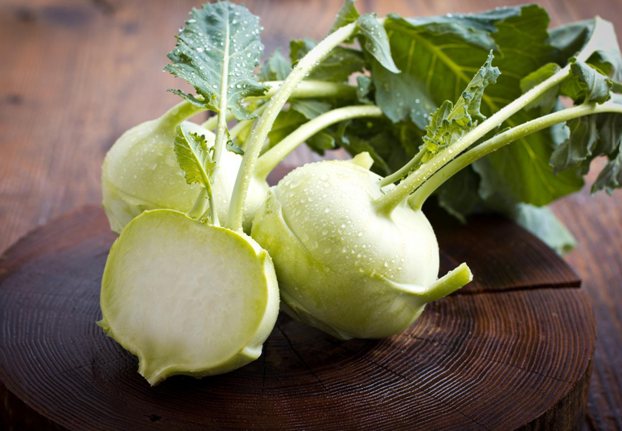

Vitamin vegetable cutaway
These include:
- thiamine (B1);
- nicotinic acid (PP);
- beta carotene;
- riboflavin (B2);
- tocopherol (vitamin E);
- retinol (vitamin A);
- pantothenic, folic acid;
- pyridoxine (vitamin B6);
- phylloquinone (vitamin K);
- choline;
- ascorbic acid (vitamin C).
Cabbage contains digestive enzymes, as well as sulfur, cobalt, magnesium, potassium, molybdenum, boron, calcium, phosphorus. Fructose and glucose give a pleasant sugary taste.
The use of kohlrabi during pregnancy
Useful properties of kohlrabi during pregnancy:
- During pregnancy often there are problems with blood vessels, varicose veins. An indispensable product in this case is kohlrabi, which dilates blood vessels, cleans them of cholesterol, and improves the overall functioning of the circulatory system.
- Relieves puffiness and removes excess fluid from the body, which suffers every pregnant woman.
- Helps work the gastrointestinal tract, eases excessive gas formation, relieves bloating, relieves constipation.
- Ideal chemical composition... It has a wide list of macro- and microelements, vitamins, organic acids, proteins, low carbohydrates, fats, cholesterol, sugar.
The negative effect is an increased diuretic effect, which is already present in excess in pregnant women.
Mothers who are breastfeeding should stop taking cabbage for a while. Fiber, useful for the mother, has a bad effect on the intestines of the baby. Your toddler may experience colic, restlessness, and bloating.
Children under one year old are very sensitive to all food products, an allergic reaction may occur.
Starting from 3 months, when the child's body becomes stronger, kohlrabi can be returned to the mother's diet. You should carefully monitor the child's reaction so as not to harm his well-being.
As a bait for a baby, it is better to give cabbage cooked - boiled or baked. Finely chopped vegetables are allowed to be consumed by a child from six months in small portions. When growing a vegetable, the use of chemicals is not allowed; cabbage, which has been damaged by diseases, is not used.
Kohlrabi vitamin puree for baby food
The composition of the vitamin puree includes: stalk kohlrabi (half a head of cabbage), potatoes (75 g), spinach leaves (110 g), high quality butter (1 tablespoon), chicken egg yolk (1).
Cooking method:
- Cabbage and potatoes are washed, peeled and chopped.
- The spinach is thoroughly washed under plenty of running water.
- Opt for a casserole or deep-walled skillet.
- Warm up the oil, add potatoes and kohlrabi cabbage. Simmer for 15 minutes over low heat, adding water.
- Put spinach with vegetables and continue to simmer for another 10 minutes.
- Boiled yolk is added to the cooled mass and, using a blender, it is crushed to a mushy state.
Serve warm, store in the refrigerator for up to 2 days. The child is given freshly prepared from the age of 6-8 months.
All puree ingredients must be fresh, undamaged, ripe, of high quality and free from chemicals.
Useful properties of kohlrabi cabbage
Vitamins and minerals determine the benefits and harms of kohlrabi cabbage for humans.
It's important to know! Regular introduction of it into the diet helps to strengthen the immune system, protect cells from mutations and the effects of free radicals, improve intestinal motility, and support the functioning of the kidneys, stomach and liver.
It has a positive effect on the work of the heart muscle, the nervous system, has anti-inflammatory and antimicrobial effects.
For men, women and children
A large amount of potassium in kohlrabi (14% of the daily value) improves heart function, reduces blood pressure. It contains glucoraphanin molecules that protect the body's cells from inflammation. Also, during grinding, a substance sulforaphane is formed in cabbage, which has an anti-cancer effect.


Kohlrabi contains a lot of potassium, which is useful for the work of the heart muscle
The presence of sulfur in kohlrabi prevents the development of malignant tumor neoplasms in the bladder, rectum. Regular use of it cuts the chances of developing breast cancer in women by almost half.
Mediterranean cabbage juice contains a lot of calcium, and in an easily digestible form. According to this indicator, it can compete with cheese and other dairy products. This is very important for young children, because calcium is needed for the growth and strengthening of skeletal bones and the proper formation of healthy teeth, as well as for adults and the elderly (especially women) with osteoporosis.
The child begins to give kohlrabi only after agreement with the pediatrician, given its beneficial properties and the presence of contraindications. It is usually allowed to enter it into the diet. after 6 months... Initially, they try to give it in the form of a puree. Gradually, you can simply bake or stew and give to the baby in small portions. Fresh cabbage should not be given to children. It causes stomach upset due to its high fiber content.


Kohlrabi puree can be prepared for children from 6 months
The benefits of kohlrabi for men lie in the general positive effect on the human body. With its help, the heart becomes stronger, the central nervous system and the digestive system function stably. In addition, the vegetable prevents the development of muscle pain and strengthens bones, which is important for men involved in active sports. This type of cabbage reduces the risk of prostate cancer, increases the duration of sexual intercourse by providing a general strengthening effect on the entire body.
The addition of kohlrabi to the diet in stewed, boiled, fresh, baked form helps to improve the condition of a person suffering from excess weight, heart disease, kidney disease, and liver disease.
During pregnancy and breastfeeding
For pregnant women, kohlrabi is also useful. It helps to improve the absorption of calcium, which is important for the formation of the skeleton and the formation of the baby's teeth. During breastfeeding, cabbage stimulates the secretion of lactate, enriches it with useful vitamins and microelements. But it is important to make sure that the baby does not have signs of allergies.


Kohlrabi must be carefully introduced into the diet of a young mother and not overeat during pregnancy
During pregnancy, in the first months, kohlrabi helps to cope with toxicosis if consumed in salads together with carrots, herbs and olive oil. You can also ferment it or pickle it, so it helps to cope with nausea and quench the passion for salty. But in the 2nd and 3rd trimester, it is better to refuse sauerkraut, otherwise swelling will appear.
Despite the benefits of kohlrabi, it can still cause harm to the health of pregnant women, especially with frequent use of a raw product.
Therefore, in the last stages it is best to eat vegetables stewed, boiled and not overeat, so that there is no pain in the stomach and increased gas formation, which can lead to increased tone of the abdominal muscles.
When breastfeeding, it is better not to introduce kohlrabi into your diet until the baby is 3 months old. After all, everything that mom eats goes into lactate, and then to the baby. And cabbage can cause him an allergic reaction and bloating.
In cooking
This variety of cabbage has a delicate and rather pleasant taste. It is eaten raw or subjected to any kind of heat treatment. You can cook young cabbage in just 5 minutes. So it becomes soft, and most of the nutrients are preserved. Kohlrabi is pre-cut into thin slices.
On a note! When frying, the vegetable acquires an unpleasant aftertaste, therefore, it must first be boiled or stewed. After that, all that remains is to fry the cabbage a little until golden brown.
You need to extinguish kohlrabi no longer than 12 minutesso that most of the beneficial substances and properties are preserved in kohlrabi. Stewed, it will be an excellent side dish for meat.You can make a vegetable stew out of it, as the vegetable goes well with almost all vegetables.
Appetizing cabbage "turnip" salad
Many cabbage varieties, including kohlrabi, are vegetables that go well with fish, meat, vegetables, cheese, mushrooms. Even if you just dip them in batter and fry, it will turn out so appetizing that even fastidious kids will not give up this yummy.
An excellent dish can be prepared from oven baked kohlrabi with béchamel sauce and cheese.
It is quite simple to do this:
- Cabbage is washed, chopped, left for 15 minutes in salted water.
- In a dry frying pan, bring the flour (a couple of spoons) to a creamy color, pour a glass of heavy cream into it and mix thoroughly until a thick sauce is formed. Salt and pepper to taste.
- 100 grams of cheese is crushed into shavings.
- Finely chopped kohlrabi is spread in a baking sheet, bechamel is evenly poured onto its surface, sprinkled with cheese shavings and placed in a preheated oven for 10-15 minutes.
The result is an unusually tasty, nutritious dish. Although, by definition, kohlrabi belongs to a cruciferous vegetable, you can cook from it not only side dishes and salads, but also such a dish as pancakes:
How to make kohlrabi pancakes
Many people eat only Mediterranean cabbage stalk. However, it also has tops (green top with 3-5 leaves), it is edible and is used in the same way as the stem crop. Only kohlrabi leaves should be juicy, not wilted, and washed thoroughly before use.
Advice! When choosing kohlrabi for cooking, you should focus only on fresh specimens with small stems. Old cabbage becomes less tasty and wood-like. The leaves should not have black dots, they show that the plant has accumulated nitrates and is dangerous to human health.
For weight loss and diet food
The low calorie content of kohlrabi cabbage, a large amount of fiber and water in it helps to maintain normal weight. The fat-burning effect of the vegetable is also due to arginine in its composition. This substance speeds up metabolic processes, improves the functioning of the digestive tract. When dieting, kohlrabi is best eaten stewed or steamed, without adding fatty sauces and oil.
In folk medicine and cosmetology
Kohlrabi can be used for various diseases as an additional prophylactic agent with restorative and medicinal properties.
Beautiful "Vienna" kohlrabi - table decoration and benefits for the body!
It helps in the following cases:
- Strengthening immunity... Just one spoonful of juice of this cabbage variety daily before meals helps to quickly restore the body's defenses.
- Cold... To lower body temperature, get rid of cough, 200 ml should be warmed up. milk, pour into it freshly squeezed kohlrabi juice in an amount of 150 ml, a teaspoon of onion juice. Drink the product warm 6 times a day, 2 tablespoons, as soon as a cough appears or there is an increase in temperature.
- Cholecystitis... With exacerbation of cholecystitis, use cabbage juice mixed with honey. For cooking, you need 2 stems and a teaspoon of natural honey. Kohlrabi is peeled, finely chopped, squeezed out of juice. From 2 stems, you get about a quarter of a glass of juice. Honey is added to it, everything is mixed and taken every day 20 minutes before lunch. An improvement in well-being is noted 10 days after the start of treatment.
- The cardiovascular system... To maintain blood vessels and the heart in a normal state, it is necessary to prepare a drink from a glass of kohlrabi juice and 2 tablespoons of grapefruit juice. Take a vitamin, fortifying agent twice a day, half a glass for a month.
In cosmetology, this variety of cabbage is used for masks.It whitens the skin, has a lifting effect, helps to cope with shallow wrinkles, narrow pores and eliminate inflammation.
A moisturizing mask can be made by combining fresh kohlrabi and cucumber crushed into gruel in equal amounts. The resulting mixture is applied to the skin in an even layer. After 25 minutes, cleanse the face with warm water. For an additional whitening effect, you can add a little fresh cream to the cucumber-cabbage mass.
Kohlrabi harm to the human body
Despite the fact that the benefits of kohlrabi cabbage for the body are enormous, in some cases, doctors do not recommend eating it. The product is contraindicated in diseases of the stomach and intestines, accompanied by high acidity: gastritis, ulcers, pancreatitis. With these ailments, you need to combine the vegetable with other products that neutralize its acid-forming properties, for example, carrots (in salads and juices).
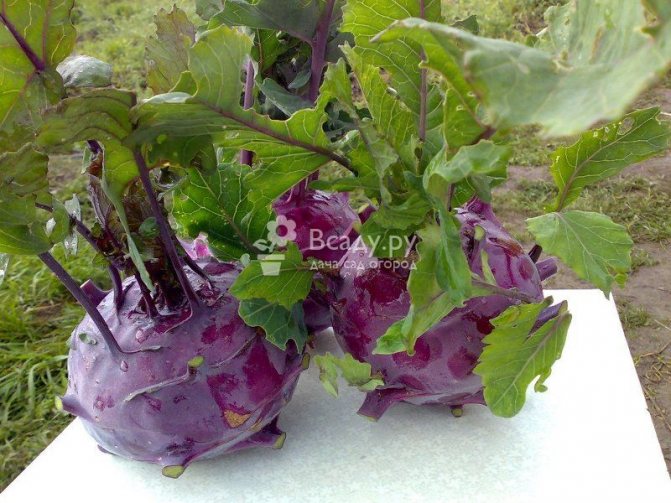

Cabbage benefits and harms raw
Danger when using store kohlrabi
An important disadvantage of the "stem turnip" is the ability to accumulate nitric acid salts (nitrates), which have a detrimental effect on all organs, in particular on the immune system and the digestive tract. Therefore, it is advisable to grow a stem crop in your garden, without the use of agrochemicals, or buy only from trusted sellers.
Contraindications to use and possible harm
Kohlrabi cabbage is useful, but in the presence of certain diseases it is better to refuse it. Otherwise, the use of this product can provoke their exacerbation.


Fresh fruits can harm people with acute gastritis and ulcers
It is recommended to refrain from Mediterranean cabbage in the following cases:
- allergic reactions;
- gastritis;
- low pressure;
- ulcer of the digestive tract.
You should not eat a vegetable with pancreatitis in an exacerbation stage. A large amount of fiber forces the pancreas to work to the limit of its capabilities, provoking a painful attack. During remission, cooked cabbage can be consumed in small portions. So it will not damage the gland, and the benefits for the body will be much greater.
Attention! It is not recommended to use kohlrabi for hypothyroidism (hypothyroidism, autoimmune thyroiditis). During ripening, goitrogenic (goitrogenic) toxins accumulate in the vegetable, which scare away pests. They suppress thyroid function.
For healthy people, there are no restrictions on the use of kohlrabi cabbage. It is only important to listen to yourself. Due to the large amount of fiber, a vegetable heavily loads the digestive organs, which can cause unpleasant bubbling in the abdomen, bloating. Therefore, it is best to consume it in small quantities. But this only applies to fresh product. Heat-treated cabbage in stews, meat or fish casseroles can be eaten almost without restrictions.
General information
The first mentions of kohlrabi were recorded in the 16th century AD. The Romans called the vegetable “kaulorapa”, which means “stem turnip”. In the old days, kohlrabi was considered a weed crop, which is why it was consumed only by the poor strata of society. The plant gained real popularity only in the 17th century, when German peasants began to grow vegetables.
The native land of the cauliflower is the island of Sicily, from where it spread throughout the continent. Today kohlrabi is grown in almost all countries of Europe, America and Central Asia. In addition, due to its cold-resistant properties, the plant is cultivated in the northern regions of Russia (Sakhalin and Kamchatka).
In appearance, the vegetable resembles a rounded rutabaga, and in terms of taste, it resembles the core of white cabbage. However, unlike its "brothers", it has a juicier sweet pulp, containing about 90% of water. The diameter of medium kohlrabi stalks is 7-10 cm, and the weight is 200-600 g.The color ranges from light green to dark purple.
The vegetable is classified as an early maturing crop, since its growing season is only 2-2.5 months. In view of this, in one season, it is possible to collect from 2 to 3 cabbage crops. Interestingly, early kohlrabi varieties are unsuitable for long-term storage (since they have tender flesh). Later types of cabbage have a denser core, which increases their shelf life.
Root crops are stored in the basement, after sprinkling with moistened sand.
Kohlrabi face masks
Fresh kohlrabi cabbage has a wonderful effect on the skin of the face - it tightens it, eliminates fine wrinkles, tightens pores and relieves inflammation.
For example, to even out the complexion and narrow the pores, you can make the following mask:
- mix a small amount of fresh cabbage juice with egg yolk;
- distribute the mask over the face and hold for 20 minutes;
- wash off with warm water.
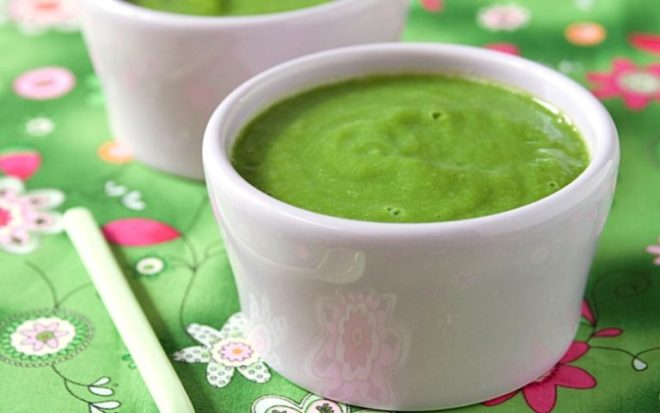

A different mask is used to moisturize and whiten the skin.
- Kohlrabi cabbage is rubbed on a fine grater, mixed with a similarly grated fresh cucumber.
- Then the mask is applied to the face and neck in an even layer.
- After 20 minutes, the mixture is washed off with warm water.
It is recommended to make masks based on kohlrabi weekly every 2 days - then the benefits will be maximum.
How to cook tasty and healthy
Salad
Ingredients:
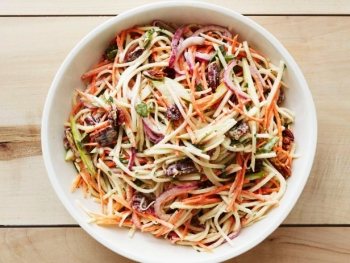

- chicken fillet - 700 grams;
- kohlrabi - 500 grams;
- cheese (soft) - 300 grams;
- apple (sour) - 1 pc .;
- onion - 1 pc.;
- walnuts - 100 grams;
- lemon juice - 50 milliliters;
- olive oil - 100 milliliters;
- sugar - 1 tbsp. the spoon;
- salt, herbs.
How to cook:
- wash the chicken, boil, cool, chop finely;
- peel the kohlrabi and apple, cut into strips;
- peel the onion, chop it in half rings;
- break the cheese into small pieces, walnuts, chop the greens;
- combine all the ingredients;
- beat butter with lemon juice, salt, sugar, season salad.
Stuffed vegetable
Ingredients:
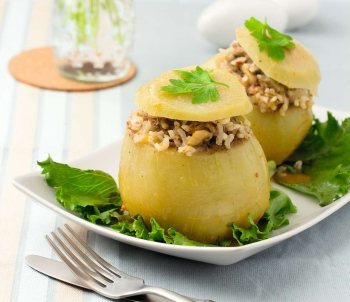

- kohlrabi - 4 heads of cabbage;
- beef - 200 g;
- rice (boiled) - 100 g;
- egg - 1 w.;
- onion - 1 pc.;
- sour cream - 250 milliliters;
- tomato paste - 100 milliliters;
- olive oil - 50 milliliters;
- salt, spices.
How to cook:
- Peel the kohlrabi, remove the middle. Cook for ten minutes in salted water;
- peel the onion, chop finely, fry in oil;
- combine meat with rice, eggs, onions, salt and spices;
- stuff the cabbage, put in a deep saucepan;
- Beat sour cream with tomato paste, pour over the resulting kohlrabi sauce. Simmer for about half an hour.
Pickled
Ingredients:


- kohlrabi - 200 g;
- pepper (sweet) - 1 pc.;
- carrots - 1 pc.;
- onion - 1 pc.;
- garlic - 3 pcs.;
- mustard (seeds) - 1 tsp;
- vinegar - 1 tbsp. the spoon;
- water - 1 glass;
- sugar - 2 tbsp. spoons;
- salt - 1 tsp;
- pepper (peas), bay leaf.
How to cook:
- peel the kohlrabi, chop it into strips, pour boiling water for a few minutes;
- cut the onion and pepper into half rings, and grate the carrots on a coarse grater;
- put spices, chopped garlic in sterilized jars, fill them with mixed vegetables;
- Boil water, add vinegar, sugar, salt to it;
- pour the resulting marinade into the jars, close them with plastic lids;
- place the cooled blanks in a refrigerator or cellar.
Kohlrabi cutlets, video recipe:
Kohlrabi care tips
Kohlrabi is undemanding to care. This is due, among other things, to the short vegetative period.
Watering
During the first 15–20 days after planting in the ground, kohlrabi is watered every 2-3 days. Further, it does not need especially frequent watering. As a rule, it has enough natural precipitation. If it is extremely hot outside, the garden is watered once a week. The water must be warmed up, the best time for the procedure is evening.


Only kohlrabi seedlings recently transplanted into the ground need regular watering
An exception is the moment when the stem grower begins to form (the plant should have 6–8 leaves). From this time on, the soil must be constantly kept in a slightly moist state so that the heads of cabbage do not crack. Mulch will help save time on watering. She will not let the weeds overgrow the garden bed.
After watering, the bed is loosened deep (6–8 cm), but only the aisles. The plants themselves do not spud. If you cover the stalk with earth, it will stretch out.
It is very important to water the kohlrabi regularly. Abrupt transitions from completely dry soil to a bed turned into a swamp is one of the main causes of cracking of stems.
Top dressing
Early kohlrabi is fed twice. A week after planting in the ground, the leaves are sprayed with a solution of carbamide and potassium sulfate (10–12 g per 10 l of water). Approximately 2 weeks before harvest - watered with infusion of fresh cow dung, bird droppings, nettle or dandelion leaves. Late varieties are fed with such infusions every 15–20 days.
Harvesting and storage
Kohlrabi meant for food can be removed whenever you want. If the stalks are planned to be stored for a long time, choose a warm, dry day. They are dug up together with the roots, dried for several hours in a place with good ventilation, protected from direct sunlight. Then the ground is cleaned off, the leaves are cut off. The stems together with the roots are folded into boxes, sprinkled with sand, sawdust, scraps of paper so that they do not come into contact with each other. Optimal storage conditions are temperature 0–2 ° С, humidity 90–95%, a dark room with good ventilation. Kohlrabi will stay in the refrigerator for a maximum of 2 weeks.
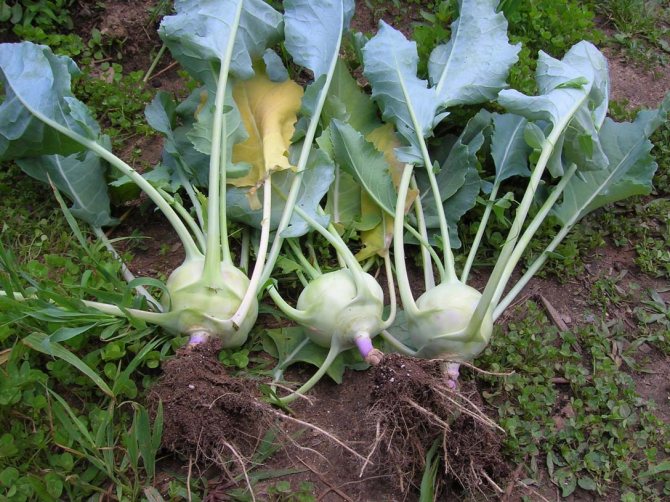

The collected kohlrabi is stored along with the roots.
Video: recommendations for growing kohlrabi
Landing
Kohlrabi is relatively unpretentious. It successfully takes root and bears fruit even on poor soils. But, of course, obtaining a bountiful harvest and the largest possible size of stems is impossible under such conditions. The ideal option is a light but nutritious substrate, such as loam.
It is imperative to find out the acidity of the soil in advance. The sour substrate of kohlrabi, like any cabbage, categorically does not tolerate. In such soil, keel almost inevitably develops. The situation can be corrected by adding slaked lime, dolomite flour, powdered eggshells (200-400 g / m²) during the preparation of the beds. Humus or rotted compost (10-15 liters per 1 m of the garden) will help to increase the fertility of the soil.


Dolomite flour is a natural soil deoxidizer that does not have any side effects
Kohlrabi is frost-resistant. Even the seedlings that have just been transplanted into the garden, which did not manage to get away from the "stress", endure a short cooling down to -2 ° C, adult plants are not damaged if the temperature drops to -8 ° C. But kohlrabi does not like heat and direct sunlight. This must be taken into account when choosing a place for the garden.
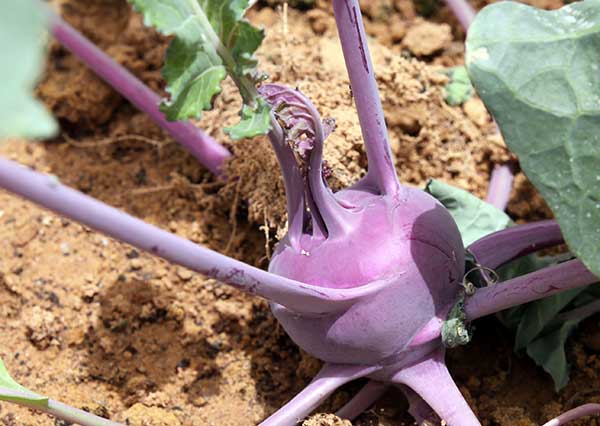

Kohlrabi does not tolerate intense heat too well, it negatively affects the quality of the fruit
Landing dates
Early kohlrabi varieties are most often grown in seedlings to bring harvest time closer. Later, since the frost resistance of the culture allows, they are planted immediately with seeds in open ground, covered with plastic wrap or other covering material.
Seeds of early kohlrabi varieties are planted for seedlings at the end of winter or at the very beginning of March. The harvest ripens by the end of May. After about 2-3 weeks, the same varieties are sown on seedlings again, for the second "wave" of fruiting, which occurs at the end of summer. To get a harvest during the summer, early and mid-season kohlrabi are planted both on seedlings and seeds in open ground in April. The optimal time for late varieties is the last decade of May or early summer.
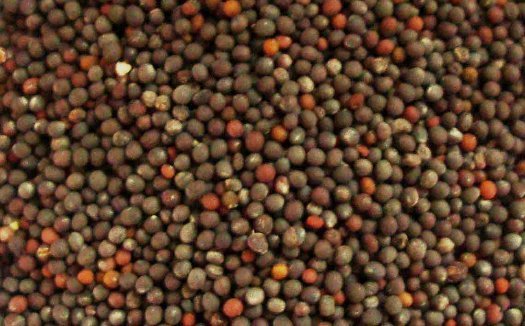

Kohlrabi seeds can be planted both on seedlings and directly into open ground
Seedling preparation procedure
- The seeds are immersed in hot (45-50 ° C) water for 15–20 minutes, then immediately into ice, literally for a minute or two. Then they are soaked for 10-12 hours in a solution of any biostimulant (Epin, Zircon, potassium humate). Folk remedies are also suitable - succinic acid, aloe juice.
- After the specified time, the seeds are washed and wrapped in a damp cloth or napkin. Then they are placed in the warmest place in the apartment. For example, you can put them in a saucer and put them on a radiator. The fabric must be constantly sprayed from a spray bottle, not allowing it to dry out.
- After 2-3 days, the seeds should hatch. When this happens, they are seated one at a time in small plastic cups or peat pots. This allows you to do without picking, which kohlrabi does not like very much - a significant number of seedlings die after the procedure.
- Soil: universal soil for seedlings or a mixture of peat, humus and fertile turf in approximately equal proportions.
- The seeds are buried by a maximum of 1–2 cm.
- The pots are covered with plastic bags to create a greenhouse effect and transferred to a dark, warm place. The optimum temperature is 20–22 ° C. As soon as the shoots appear, they are provided with light and the temperature is sharply lowered to 8 ° C. After 8-10 days, it is raised again to 17-20 ° C during the day and 11-13 ° C at night. If it is warmer, the plants will stretch ugly.
- To prevent the development of "black leg", kohlrabi seedlings are watered only with water at room temperature, alternating with a pale pink solution of potassium permanganate. When the plants form two true leaves, they are fed with a solution of any complex fertilizer for seedlings (Sprout, Ideal).
- They begin to prepare seedlings for planting in about 2 weeks, hardening them. The time spent outdoors is gradually extended from 1–2 hours to 10–12 hours. A week before planting, kohlrabi stop watering.
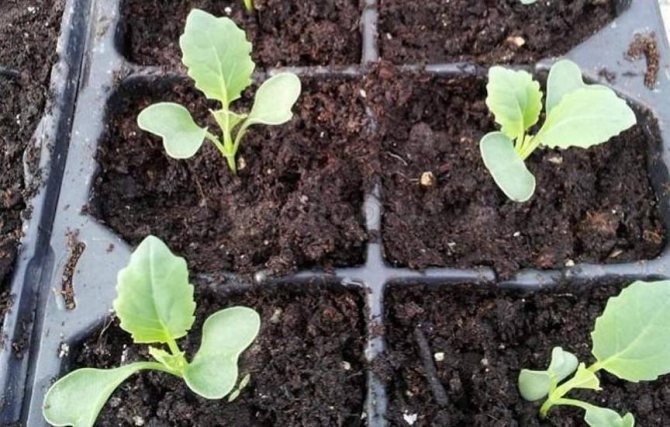

Kohlrabi seedlings appear quickly and amicably
Planting seedlings in the ground
Kohlrabi seedlings are ready for planting in the ground a month after the shoots appear. It should have 3-5 true leaves standing upright. It is not recommended to hesitate with disembarkation. The stem fruit will either not form at all, or it will turn out to be deformed, and the pulp will be tough, not juicy, fibrous.
Early kohlrabi seedlings are planted as soon as the soil warms up to 8–10 ° C. If you delay, the plants can go into the “arrow”. Late is transferred to open ground in the second decade of July to harvest in September or in the first half of October.
Kohlrabi compares favorably with other types of cabbage in that each plant needs a very small area for nutrition. Between them leave about 20-25 cm, between the rows - about 30 cm. On 1 m², thus, "get along" 8-10 plants.
Step by step process:
- Before planting seedlings, each hole 6-10 cm deep is well watered and fertilized - 8-10 g of simple superphosphate and a handful of sifted wood ash.
- All this is mixed, the bushes are planted in the resulting "mud" at the bottom of the hole. When landing in the ground, kohlrabi is not buried more deeply than before. The root collar should be at about the same level, because the stem crop is formed just above it. Ideal if the seedlings are grown in peat pots. Then the plants do not need to be removed from the container at all.
- Then the soil is carefully compacted, watered and mulched again. Peat and sawdust, especially coniferous ones, are not suitable for this - they strongly acidify the soil.
- The best time for the procedure is the evening of a cloudy cool day. Then for 7-10 days above the plants, it is advisable to build a canopy of any white covering material to protect them from direct sunlight.
Neighbors for kohlrabi
Growing kohlrabi in greenhouses and hotbeds is undesirable, especially together with other crops that require frequent feeding, including mineral fertilizers. Kohlrabi, on the other hand, accumulates nitrates very quickly in the stem.
When choosing a place for kohlrabi, you need to take into account what has grown on this bed earlier. Bad predecessors are other plants from the Cruciferous family. But it is quite possible to plant it after cucumbers, tomatoes, potatoes, beets, carrots, onions, garlic, any spicy herbs and legumes.
Sowing seeds in the ground
Kohlrabi seeds are planted directly into the ground in grooves 2-3 cm deep with an interval of about 30 cm between them. The furrows are sprinkled with a thin layer of humus, the bed is tightened with any covering material. Seedlings are thinned out when the first true leaf is formed, carefully cutting off weaker plants with scissors. If you pull them out, you can damage the roots of neighboring seedlings.

